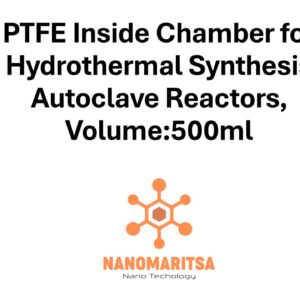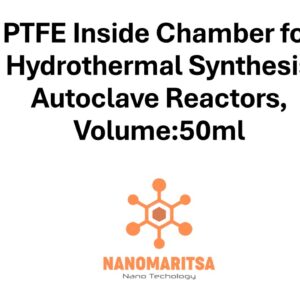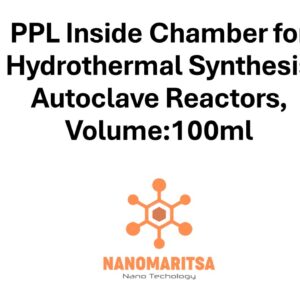PTFE Inside Chamber for Hydrothermal Synthesis Autoclave Reactors, Volume:100ml
€144.00
ComparePTFE Inside Chamber for Hydrothermal Synthesis Autoclave Reactors (100 ml) is a specialized component used in hydrothermal synthesis autoclave reactors. This chamber is where high-temperature and high-pressure chemical reactions take place, allowing for the synthesis of advanced materials, such as nanoparticles, crystals, and other inorganic compounds. Below is an overview of its key features, properties, applications, and safety considerations:
1. Key Features:
- PTFE Lining: The PTFE (polytetrafluoroethylene) inside chamber is designed to be chemically inert, non-reactive, and highly resistant to a wide range of acids, bases, and solvents. This ensures that no unwanted reactions occur between the reactants and the chamber’s interior, maintaining the purity and stability of the synthesis process.
- Volume (100 ml): The chamber has a 100 milliliters (ml) volume, making it suitable for moderate-scale hydrothermal reactions. This size is ideal for research and small-scale industrial processes where a larger volume of material needs to be synthesized or tested.
- Pressure and Temperature Resistance: The PTFE chamber is designed to withstand high pressures (up to 200-300 bar) and high temperatures (150°C to 250°C), which are necessary for hydrothermal reactions. This allows for a variety of advanced material syntheses that require such extreme conditions.
- Sealed Environment: The PTFE chamber is sealed within the autoclave reactor to maintain precise control of reaction conditions. This ensures that the temperature, pressure, and chemical environment inside the chamber are optimized for the synthesis process.
2. Properties:
- Chemical Inertness: The PTFE material ensures that the chamber does not react with most chemicals, allowing for the safe synthesis of a wide variety of materials, including corrosive or reactive compounds.
- High Temperature and Pressure Resistance: PTFE can withstand temperatures of up to 250°C and pressures up to 200-300 bar, which is ideal for hydrothermal synthesis, where such extreme conditions are often required to drive the reaction and achieve desired material properties.
- Non-Stick Surface: PTFE’s non-stick surface ensures that synthesized materials do not adhere to the chamber walls, allowing for easy recovery of products and preventing contamination during synthesis.
- Uniform Reaction Environment: The sealed environment in the chamber ensures that the temperature and pressure are uniform throughout the reaction, leading to consistent and controlled outcomes.
3. Applications:
- Nanomaterial Synthesis: The PTFE chamber is often used for the synthesis of nanoparticles and nanomaterials, which are employed in a variety of fields such as electronics, catalysis, and energy storage.
- Crystal Growth: Hydrothermal synthesis is an effective method for growing single or polycrystalline materials, including metal oxides, semiconductors, and other inorganic compounds, and the PTFE chamber is ideal for such applications.
- Catalysis and Chemical Reactions: The chamber is suitable for reactions that require high temperatures and pressures, such as the synthesis of catalytic materials or the modification of chemical compounds to achieve specific properties.
- Energy Materials: Hydrothermal synthesis is widely used in the preparation of materials for energy applications, such as electrodes for batteries, supercapacitors, and fuel cells.
- Environmental Applications: The PTFE chamber can also be used to synthesize materials for pollution control, water purification, and environmental remediation, as well as for developing new catalytic systems for energy and environmental technologies.
- Advanced Ceramics and Composites: This reactor chamber is ideal for producing high-performance ceramics and composites, which are essential for applications in sensors, electronic devices, and coatings.
4. Handling and Safety:
- Toxicity and Corrosiveness: While PTFE is highly resistant to chemical reactions, the reagents used in the hydrothermal synthesis process may still be toxic or corrosive. Always ensure that the materials inside the chamber are compatible with PTFE and take necessary precautions when handling hazardous chemicals.
- High Pressure and Temperature Safety: The reactor chamber operates under extreme pressure and temperature conditions, so it is important to follow all safety protocols to prevent accidents. Always inspect the chamber for damage, and ensure that it is properly sealed before initiating the reaction.
- Storage: After use, clean the PTFE chamber thoroughly to remove any chemical residues. Store it in a cool, dry location, away from direct sunlight or extreme temperatures, to ensure its longevity and performance.
- Precautions: Always wear appropriate personal protective equipment (PPE) such as gloves, goggles, and lab coats when handling the PTFE chamber. It is recommended to work in a well-ventilated area or under a fume hood to minimize exposure to harmful chemicals, vapors, or gases generated during the reaction.
Summary:
The PTFE Inside Chamber for Hydrothermal Synthesis Autoclave Reactors (100 ml) is a crucial component for conducting controlled hydrothermal synthesis reactions at laboratory scale. Its PTFE lining ensures that the chamber remains chemically inert, durable, and resistant to high temperatures and pressures, making it ideal for the synthesis of advanced materials, including nanomaterials, crystals, and catalytic systems. The 100 ml volume provides flexibility for moderate-scale reactions, allowing researchers and developers to synthesize larger quantities of material while maintaining precise control over reaction conditions.
| Pieces | 1 Piece, 5 Pieces |
|---|






